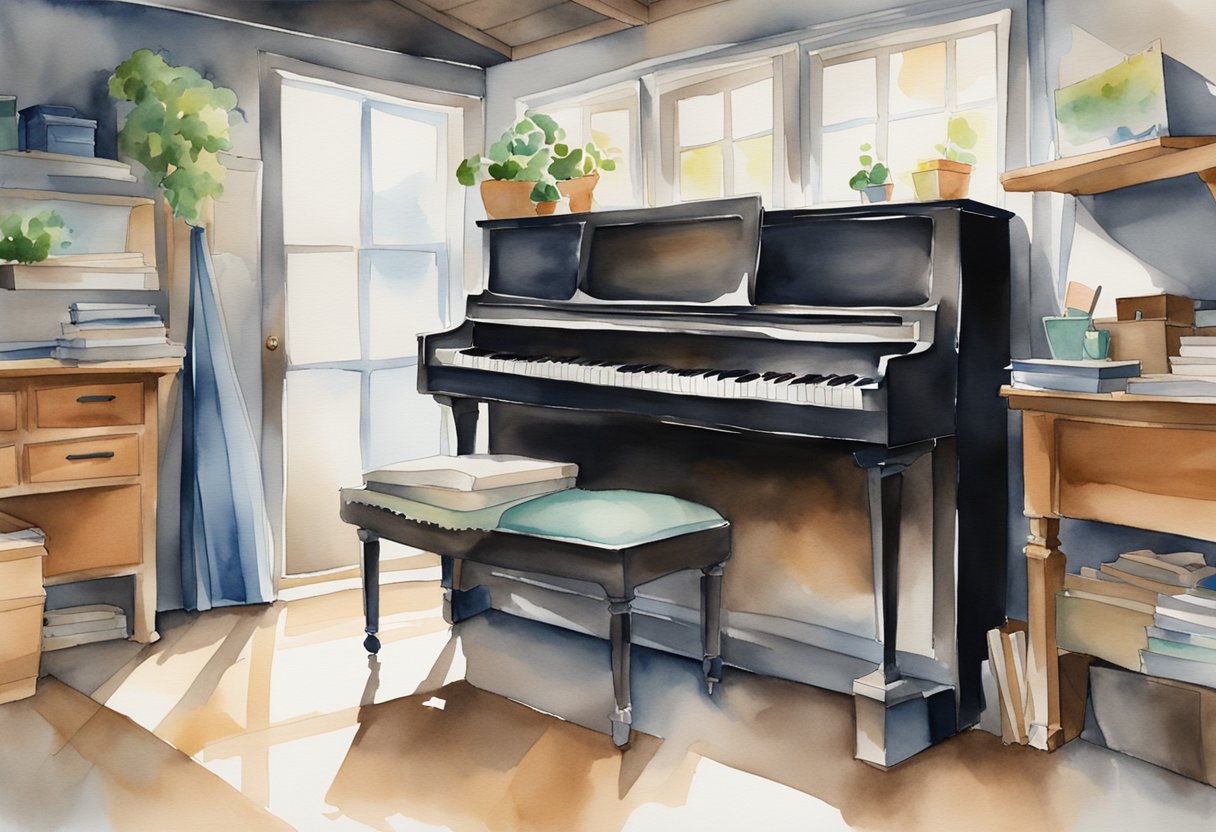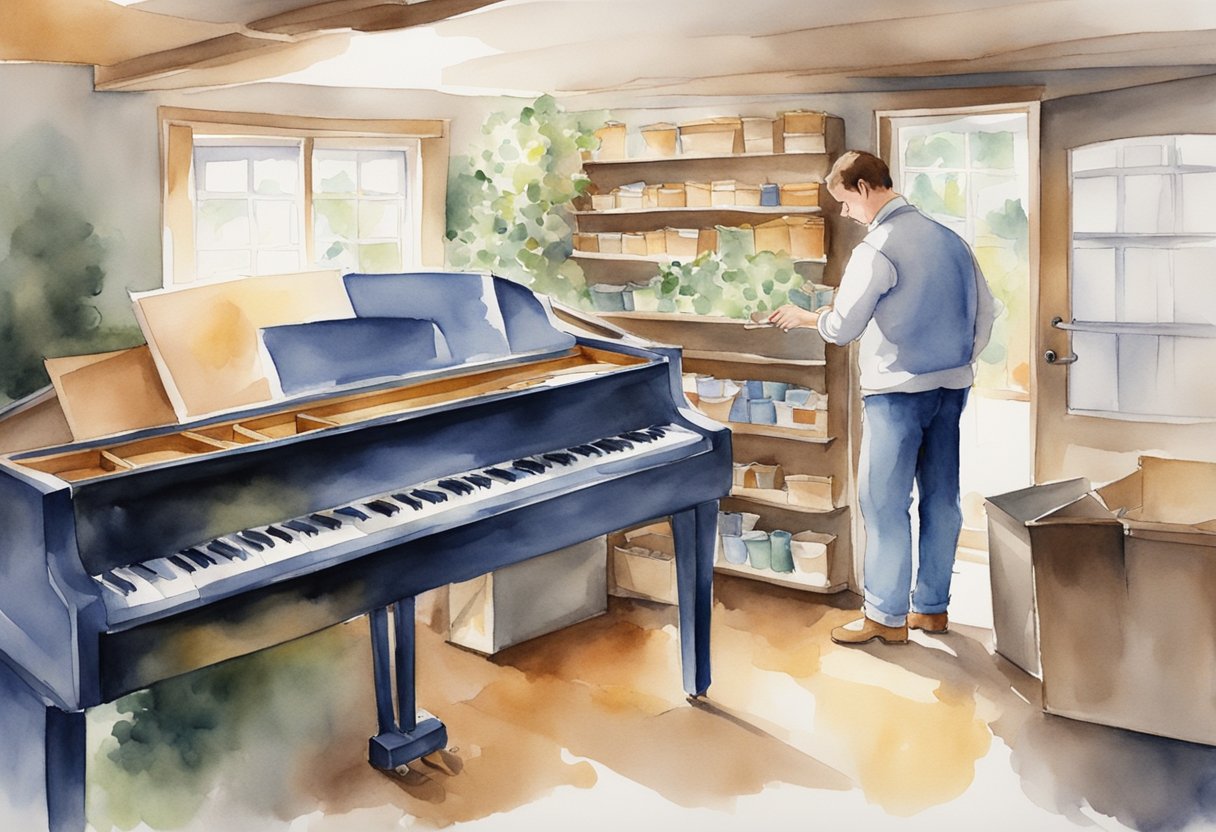As an Amazon Associate I earn from qualifying purchases.
Storing a piano in a garage is possible, but it comes with significant risks that you should consider. The fluctuating temperatures and humidity levels typical of a garage environment are quite harsh on the delicate wooden components and precision mechanisms inside a piano.
Want to Learn Piano?Click Here

For instance, I recall a colleague who kept a grand piano in her garage. Despite her meticulous maintenance routines, the piano eventually required extensive repairs due to the uncontrolled climate. In a less-than-ideal storage situation like a garage, continuously monitoring and adjusting the temperature and humidity levels would be essential to minimize potential damage.
If you decide to proceed with storing a piano in your garage, ensure the space is as consistent with the interior conditions of a home as possible. Invest in a good-quality cover to protect against dust and consider using humidity control devices to stabilize the environment. Remember, each piano is not just an instrument, but a substantial investment and an heirloom that merits the best care we can provide.
Assessing Risks and Preparing for Piano Storage

Before tucking your piano away in a garage or storage unit, recognizing the risks and prepping accordingly is essential to preserve your instrument’s integrity and sound quality.
Understanding Temperature and Humidity Effects
Your piano is like a living entity, with wood and felt parts sensitive to the ebb and flow of temperature and humidity. Fluctuations can cause wood warping, sticking keys, and even tuning instability, as the wooden components expand and contract. In extreme cases, the soundboard might crack, an expensive fix.
To avert these risks, climate control is key. A climate-controlled storage unit maintains a consistent environment, which is crucial for your piano’s longevity.
Securing the Piano Before the Move
Even before entering storage, your piano needs protection. Cleaning your piano to remove any debris and securing loose parts can prevent damage during the move. Wrapping the piano in protective blankets and securing with tape can reduce the risk of scratches or dents.
Ensure the piano cover is on. This may seem like a lot, but remember, moving can be one of the riskiest moments for your instrument.
Choosing the Right Storage Space
Finding the ultimate spot for your piano goes beyond just an empty corner in the garage. Concrete floors in garages can store moisture, leading to damp air around your piano. Instead, consider a climate-controlled storage unit to safeguard against dampness and temperature extremes.
Within this space, positioning matters too. Keep your piano away from direct sunlight, heat sources, and ensure proper ventilation—a little foresight goes a long way in keeping your piano at rest without worries.
Maintaining the Piano While in Storage
Before stashing your prized instrument away in the garage, understanding how to maintain your piano during this time is crucial. Proper care ensures that when it’s time to bring the music back, your piano remains in peak condition, ready to fill the space with its harmonious charm.
Regular Care and Tuning
At the heart of your piano’s maintenance is the regular care and tuning of its components. Even when not actively played, the strings of your piano can lose tension, causing the pitch to drop. It’s important to tune your piano regularly, at least once every six months, to maintain its correct pitch and tension. This not only preserves the quality of music but also prevents undue stress on the piano’s structure.
Protecting Against Pests and Climate Fluctuations
Your piano is not just an instrument, but also a delicate ecosystem susceptible to pests and climate fluctuations. Use thick blankets or a cloth to cover the piano and protect its finish from dust and scratches. Regularly check the environment for signs of mold, mildew, and pests that can damage the piano’s wooden and felt components.
Accessing and Using the Piano
While your piano is in storage, you may still wish to access and play it from time to time. Plan for accessibility, making sure there is enough room for a bench and for you to sit comfortably. When moving the piano in and out of storage, always use professional piano movers to avoid damaging the instrument or your back.
Proper moving and storing of your piano involves disassembling certain parts, such as the lyre, music rack, and sometimes the legs of a grand piano, to secure it during transport.
Remember that your piano is not just a piece of furniture, but a living instrument that thrives with attention and care, even in storage.
Hello & thanks for stopping by! I’m a professional concert pianist and piano instructor. In the United States, I’ve given successful performances in several places including New York, Florida, Connecticut, & New Jersey, I have also performed internationally in Italy and made my Carnegie Hall debut in 2014. I enjoy blogging about the piano, the art of performance, general music, current events and the latest in music production.
